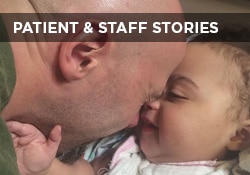This website uses cookies so that we can provide you with the best user experience possible. Cookie information is stored in your browser and performs functions such as recognising you when you return to our website and helping our team to understand which sections of the website you find most interesting and useful.

Susan E. Mazer, Ph.D. Blog
Thoughts and ideas on healthcare
Hi, and welcome to my blog! I'm Susan E. Mazer -- a knowledge expert and thought leader on how the environment of care impacts the patient experience. Topics I write about include safety, satisfaction, hospital noise, nursing, care at the bedside, and much more.
Is Integrative Medicine in Better Alignment With the New Patient Experience Model?
October 13, 2017
 Last month, billionaires Henry and Susan Samueli donated $200 million to the University of California Irvine to build a College of Health Sciences that will incorporate integrative health research, teaching, and patient care across its schools and programs.
Last month, billionaires Henry and Susan Samueli donated $200 million to the University of California Irvine to build a College of Health Sciences that will incorporate integrative health research, teaching, and patient care across its schools and programs.
The pushback has been rather dramatic.
Medical school faculty at U.C. Irvine immediately criticized this facility. Others did, too. A news item on MedPage Today quoted a Yale physician comparing the donation to the Medical School for an Integrative Medicine Program to an astronomy department “taking money for an astrology wing.”
In other words, regardless of the research and well-documented outcomes, practices that do not fit neatly into the allopathic paradigm are unacceptable, voodoo, or hocus-pocus.
A Holistic Approach to Care
According to Duke Integrative Medicine, integrative medicine is “an approach to care that puts the patient at the center and addresses the full range of physical, emotional, mental, social, spiritual and environmental influences that affect a person’s health.”
It combines traditional medicine with other well-researched therapies that have been shown to be effective and safe, such as acupuncture, mindfulness practice, energy medicine, and herbal medicines. Integrative medicine also incorporates music and art, and the power of story.
Thematically, integrative medicine looks to the mind and the body partnering in healing and health.
By its nature, integrative medicine engages patients, requiring not only their participation but also their own ability to understand the power of their beliefs, attitudes, and knowledge as they inform their health. It addresses and mobilizes the relationship between mind and body, and between emotions and the hormones that are stimulated, such as cortisol.
What this means is that patients can influence their own physiology and, in doing so, have power in their own future beyond taking medication.
This is contrary to current allopathic practices that assume the body has its own set of rules that are not informed by belief, attitude, or anything but the laws of nature that can be measured and confirmed.
Nonetheless, evidence-based medicine calls upon the physician (or nurse) to include the patient’s values, preferences, and beliefs in the equation of appropriate treatment.
This has many implications for the patient experience.
What Role Does the Physical Environment Play?
Martha Rogers’ theory of Unitary Human Beings says that we are integral to the universe and one with our environment. For nursing, this supports the critical nature of the physical environment of care in all aspects of caring, treatment, and health.
The concept of a healing environment is about making visible the compassion and empathy that is promised by the healthcare provider. Even better, research on how the physical environment affects outcomes has made a connection between things like light, color, surface materials, room layout, etc. on patient safety and recovery.
Research has also pointed to the need to reduce/minimize environmental stressors while providing positive distractions, including nature and music.
Ensuring that patients’ experiences are positive begins with where they find themselves and who is caring for them. The evidence of the effectiveness of human caring is also well researched.
Intentionally Linking the Patient Experience to Outcomes
The bottom line is that healthcare providers must shift their language and intentionally link the patient experience to clinical outcomes.
Many are already doing this, as a report by the Beryl Institute confirmed earlier this year, but it’s also important to integrate mind-body practices that balance the passive relationship between the patient and medications with an active relationship with integrative therapies.
And, as we have seen, existing paradigms and beliefs hold on tightly.
To add what is missing in traditional medical practices that only look at the body mechanistically, the healthcare industry needs more integrative medicine programs like the one at UC Irvine. And to improve outcomes, healthcare providers must begin to look at the whole patient, and the whole patient experience, which is far more complex that can be accurately measured by the 31-question HCAHPS survey.
We are making progress. But more is needed.
The patient experience cannot be separated from patient safety, comfort, anxiety, hope and fear, toxicity, or trust and uncertainty. The patient experience is everything and everyone.
P.S. If you like this post, please do me a favor and share on LinkedIn, Twitter, Facebook, etc. Also to get automatic notices when a new post is published, please subscribe. No spam – just great content. Thanks!










